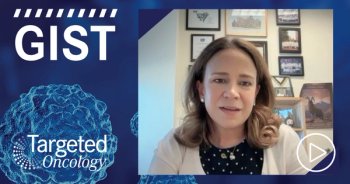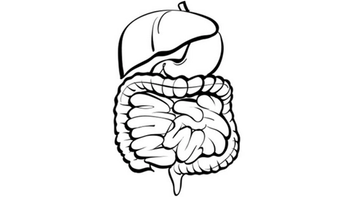
Presentation of a Gastrointestinal Stromal Tumor Case
Neeta Somaiah, MD: Hello. I’m Neeta Somaiah, a sarcoma medical oncologist at The University of Texas MD Anderson Cancer Center. One of my specialties is treating gastrointestinal stromal tumors. Today I’m going to be presenting a case, followed by a discussion. The case is of a 68-year-old man with a diagnosis of a gastrointestinal stromal tumor [GIST]. He initially presented with complaints of decreased appetite, vague abdominal discomfort, and a sensation of fullness that was preceding the 4 months of his presentation to clinic. His past medical history included diabetes that was medically controlled. He had had a colonoscopy at age 50 that was unremarkable, with no family history of cancer.
The physical examination showed abdominal pain on deep palpation, but was otherwise unremarkable. His clinical work-up previously included laboratory testing that showed a hemoglobin of 10.5 g/dL, his platelets were 105,000, and the other lab values were within normal limits.
He previously had had an endoscopy that showed a submucosal 6 cm mass with ulceration, and he had an endoscopic ultrasound following that showed a mass with irregular borders on the extraluminal surfaces with a marginal halo and hyperechogenic spots. The FNA [fine needle aspiration] biopsy showed a gastrointestinal stromal tumor with KIT on immunohistochemistry, and mitotic activity showed greater than 5 mitoses per 50 high-power field. This was sent out for targeted mutational testing and it was negative for KIT or PDGFR mutations.
The abdominal pelvic CT confirmed the 6.2 cm mass with indistinct margins in the body of the stomach. The MRI revealed 3 small hepatic lesions consistent with metastases. The diagnosis was stage IV GIST. His performance status was 0. He was started by his physician on imatinib, 400 mg orally once daily. It was continued for approximately 24 months until he complained of some increased abdominal pain and an additional 8-lb weight loss from his baseline.
His ECOG performance status had declined to approximately 1, the imatinib was discontinued, and he was initiated on sunitinib, 50 mg once daily for 4 weeks, with a 2-week drug-free interval. The treatment was initially well tolerated for around 3 cycles. Then he developed some nausea, emesis. The dose was reduced to 25 mg once daily, without resolution of his adverse events. Then the sunitinib was discontinued.
He was then switched to regorafenib 160 mg once daily for the first 21 days, with 3 weeks on for each 28-day cycle, so it was a 1-week drug-free interval. His repeat blood work showed the hemoglobin had dropped to 8.9 g/dL. His AST [aspartate aminotransferase] was elevated at 65 IU/L, and the regorafenib was discontinued. The patient was then started on ripretinib 150 mg orally once daily.
Is this the typical kind of patient I see? Yes. Quite often patents present to me in various lines of their treatment with metastatic GIST. If they present to me early, of course the mutational status is important for me to take into account. There are some additional tests I would do on their tissue if they were wild-type for KIT or PDGFR.
In addition, as they progress through the different lines of standard therapy, I do sometimes dose sunitinib and regorafenib differently to improve tolerance. For those drugs sometimes I also start lower than the standard dosing that is approved because patients, especially elderly patients, or with poor performance status, have trouble tolerating the full dose. We tend to start low and then go high, and we’re able to get most people to tolerate it, at least in a lower dose, and a small fraction have to discontinue purely based on adverse effects.
This is the usual process of progression we see with patients with GIST. This patient had a wild type for KIT or PDGFR, and this does tend to be a smaller percentage of the population of patients with GIST.
Transcript edited for clarity.
Case:
A 68-Year-Old Man With Gastrointestinal Stromal Tumor
Initial presentation
- A 68-year-old man complains of a 4-month history of decreased appetite, vague abdominal discomfort and a sensation of fullness
- PMH: DM, medically controlled; colonoscopy at age 50 was unremarkable; no family history of cancer
- PE: abdominal pain on deep palpation; otherwise unremarkable
Clinical workup
- Labs: Hb 10.5 g/dL, plt 105 x 109/L; other lab values WNL
- Endoscopy: showeda submucosal ~6 cm mass with ulceration
- EUS: irregular borders on extraluminal surfaces with marginal halo and hyperechogenic spots
- FNA biopsy: mitotic activity showed >5 mitoses/50 HPFs
- Mutational testing: WT-GIST
- Abdominal/pelvic CT confirmed a 6.2 cm lesion with indistinct margins in the body of the stomach
- MRI showed 3 small hepatic lesions consistent with metastases
- Stage IV; ECOG 0
Treatment
- He was started on imatinib 400 mg PO qDay, continued for 24 months until he complained of increased abdominal pain and an additional 8-lb weight loss
- ECOG 1; Imatinib was discontinued
- Treatment initiated with sunitinib 50 mg PO qDay for 4 weeks, with a 2-week drug-free interval
- Treatment was well tolerated for 3 cycles when he developed nausea and vomiting; dose reduced to 25 mg PO qDay without resolution of AEs; sunitinib was discontinued
- Regorafenib 160 mg (four 40 mg tablets) PO qDay for the first 21 days of each 28-day cycle was started, poorly tolerated
- Repeat lab work showed: Hb 8.9, AST 65 IU/I; regorafenib was discontinued
- The patient was started on ripretinib 150 mg PO qDay









































